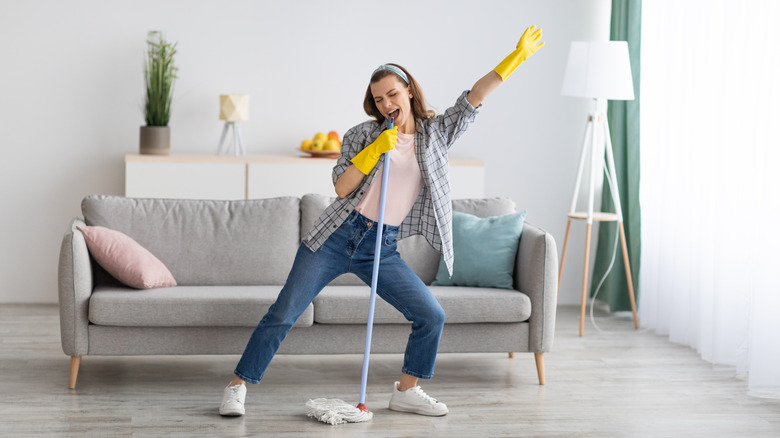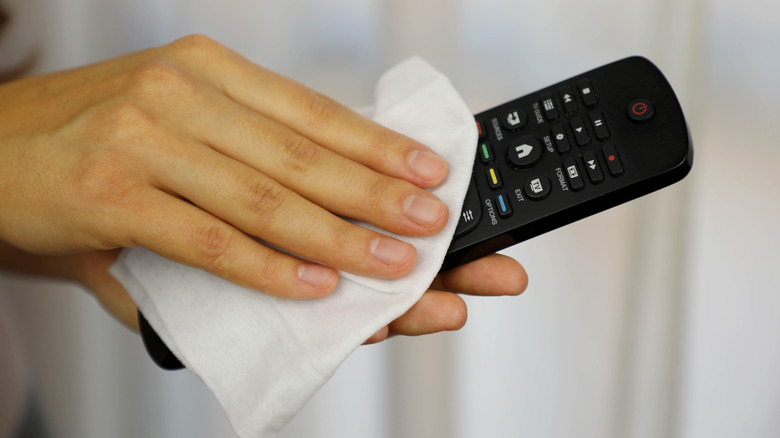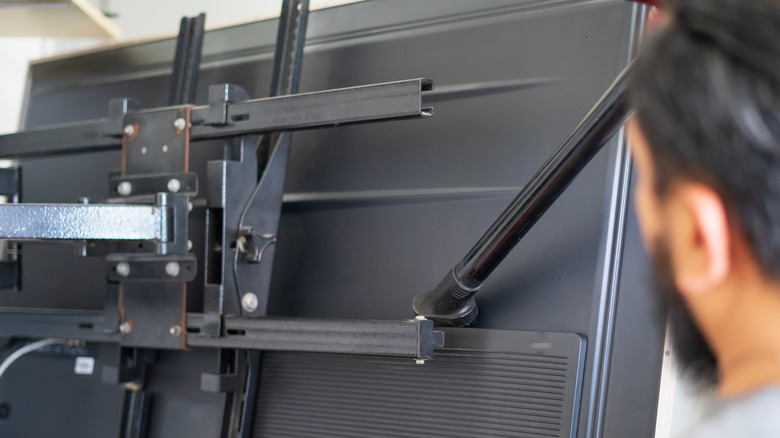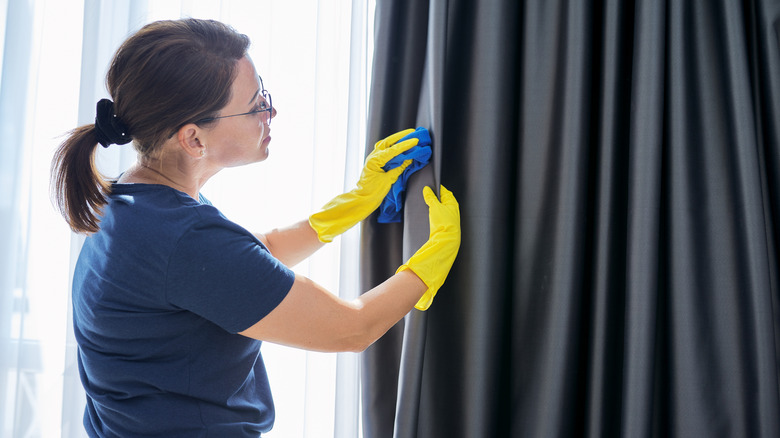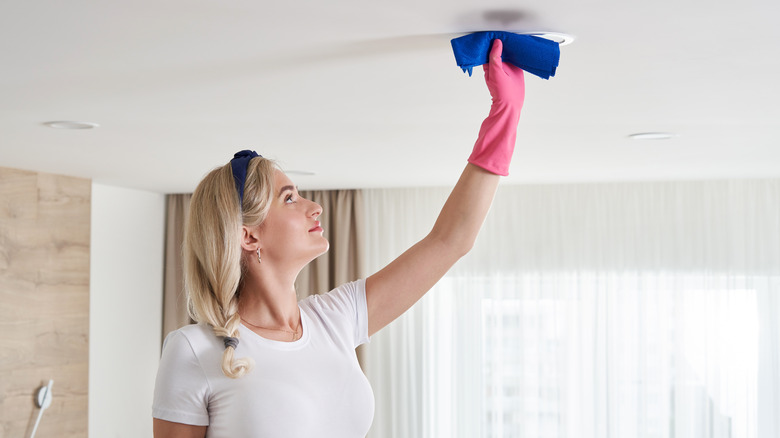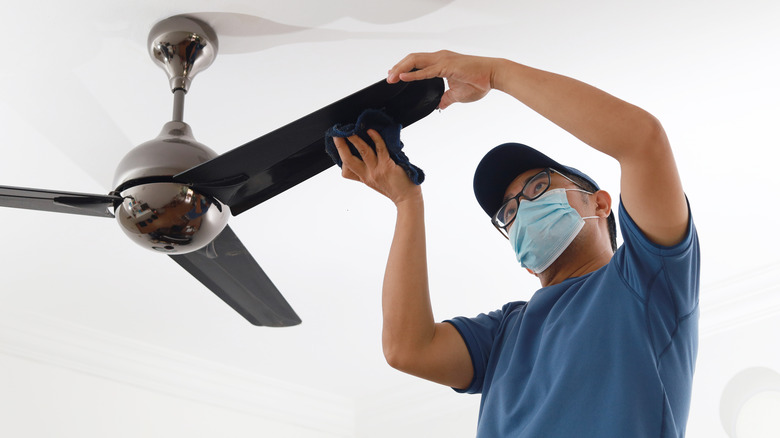5 Things In Your Living Room You Are Forgetting To Clean
According to Oh So Spotless, people who are meticulous about their home maintenance and are committed to a timely cleaning schedule live happier and healthier. Besides, a clean house provides the perfect atmosphere for productivity and guest-hosting, while it also brings a sense of pride and achievement. But as it stands, house maintenance is a chore of chores. One moment, you're scrubbing sticky dirt off the bathroom wall, and the next moment you're cleaning the drawer pulls in the kitchen.
However, of all the spaces that are tricky to keep dirt-free and tidy, the living room can be the trickiest. This is especially true for people living with pets. Therefore, it is quite likely that you've likely been missing some details each time you clean your living room. To that end, we have identified a few things in your living room you may be forgetting to clean, and also provided the most efficient, time-saving, and easy ways to do so.
Remote controls
Not many things get dirtier than your TV or stereo remote and your game controllers. According to Metro News, research suggests that a computer gamepad controller harbors five times more bacteria than an average toilet seat. And the cause of this is not farfetched. Controllers and remotes are handled frequently in our homes and often by different people. Certainly, this is enough reason to clean them regularly.
Before cleaning the remote controls, you should take out the battery and then proceed to sanitize the surface. Wipe around the buttons with a slightly damp cloth with an addition of alcohol as it kills germs faster. If the cloth does not provide the desired result, you should use a can of compressed air to eliminate the dirt buildup around the buttons. Ensure there is no corrosion in the battery compartment and leave to dry before replacing the battery. The Center for Disease Control and Prevention (CDC) recommends cleaning and disinfecting your remote daily. Sanitize your hands before and after cleaning your controllers, and do so as needed.
Behind the TV
You may not realize how much dust has accumulated behind the TV until you're about to move, replace some faulty wire, or rearrange your sitting area. The reason why so much dirt gathers behind the TV is that the electrical component that provides power to the TV is a static magnet that generates heat and sucks in the dust. Aside from having a dusty appearance, experts at Tech Wella say that excess dust in the TV set can cause short circuits, a reduction in image quality, and control issues.
Before you get to work on cleaning behind your TV, you must first unplug every electrical connection from the power outlet for safety. This is also a good time to dust the cords to get rid of the accumulated debris. With the help of a microfiber cloth, wipe down the back of the TV from the front, then wrap it all up by vacuuming the dirt off the floor. Powerizer Clean discourages using paper towels on your TV as they tend to leave fibers or scratches on the surface.
Curtains
Curtains provide the necessary privacy, keep our homes cool, and block out excess light. We tend to pay less attention to the curtains because they aren't used frequently and are often made of materials that hide stains. However, the Mayo Clinic explains that washing the curtains frequently is important to keep the home free of pollen allergies, dust, pets, and mold.
According to Consumer Report, it is important to carefully check the care label of your curtains, as some types of material cannot be placed in a washing machine. If yours are machine washable, do so on a gentle cycle as the seams and linings can easily shrink or tear. Home Decor Bliss recommends sending curtains made of silk or other delicate materials to the dry cleaner. They also suggest that to avoid discoloration, sheer curtains should be washed more frequently, even if they do not look so dirty.
Lamps
More than just a home accessory, lampshades add some personality to a room and complement the glare of the other bulbs. Lamps are usually pricey, and this is enough reason to keep them in good condition. Per Juniper Design, cleaning and dusting your lamps weekly will help keep them looking new for as long as possible. To clean your lampshade, you'll need a lint roller, cotton gloves, a vacuum attachment, soap solution, baking soda, and a soft-bristled brush.
As suggested by HGTV, first, you should carefully remove the lampshade. After this, wipe off any visible dust with the lint roller and use your soft-bristled brush on stubborn areas. Continue by cleaning the interior of the shade with a fiber cloth soaked in soap solution. If your lampshade has fabric embroidery, gently spot-scrub with your soft-bristled brush dipped in the soap, wipe it with a damp piece of cloth, and air-dry it. In a situation where your lampshade is exceptionally dirty, dip it in a basin of warm soapy water and give it a thorough wash with a microfiber cloth, and finally rinse and dry it.
Ceiling fan
Cleaning your ceiling fan might not be a high priority on your list. Ceiling fans are tough to reach, and one would assume since the blades are spinning, all is fine... Well, not quite. The upper surface of the blades is most likely covered in dust, especially in the winter months, and according to Sleep Advisor, dust and fans can contribute to allergy symptoms.
Luckily, DelMar shares some tips on cleaning your ceiling fan. You might need assistance from a stool and a cloth dipped in a cleaning solution. Before you begin, you should protect yourself against the dust from the blades' surrounding area, and make sure your mouth and nose are covered. Wrap the cloth around the blades and slide it slowly as it collects the grime from the blade. Alternatively, a less stressful method to clean your fan, according to DelMar, is using a duster with an extendable arm that reaches several feet, allowing you to clean the ceiling fan without using a ladder or stool.
